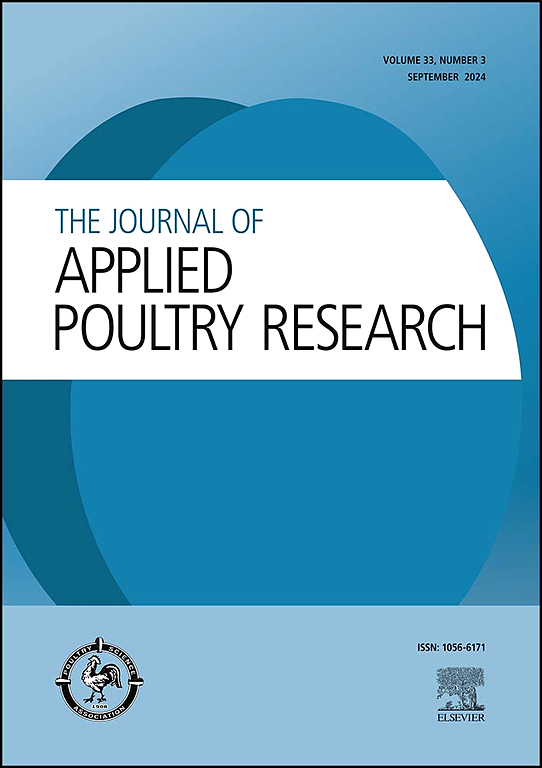利用多向可见/近红外光谱和机器学习技术测定棕卵的生育能力
IF 2
3区 农林科学
Q2 AGRICULTURE, DAIRY & ANIMAL SCIENCE
引用次数: 0
摘要
家禽产品提供价格低廉的蛋白质,可满足人类日常营养需求。随着人口的不断增长,家禽业在过去几十年中得到了强化和机械化。孵化场是现代综合家禽业的关键组成部分,为商业生产提供雏鸡。在孵化的最初几天检测蛋的受精率,可使孵化场及时排除不育蛋或有问题的蛋,从而减少孵化空间、公用事业成本和爆炸蛋的污染。本研究的目的是通过多向点可见光/近红外(VIS/NIR)光谱和机器学习研究褐壳蛋育性检测。从孵化的第 0 天到第 5 天,共使用点可见光/近红外光谱对 130 枚褐壳蛋进行了测量。鸡蛋的光谱图像从三个方向(X、Y 和 Z 轴)采集,光谱范围为 190-1100 纳米。四种预处理方法(如 Savitzky-Golay、高斯、乘法散射校正和标准正态变异)被单独或联合使用,以过滤光谱中不需要的数据和噪声。然后使用主成分分析和 T 检验进行特征选择。最后,根据过滤后的数据和提取的特征,使用支持向量机分类器确定褐壳蛋的受精率。结果表明,在孵化的第 0、1、2、3、4 和 5 天确定褐壳蛋受精率的最佳精确度(%)分别为 90.3、90.9、91.3、91.9、92.3 和 94.3。所提出的框架是在孵化早期阶段确定鸡蛋受精率的有用工具,有助于家禽生产的高效和可持续发展。本文章由计算机程序翻译,如有差异,请以英文原文为准。
Determination of brown egg fertility by multi-directional visible/near-infrared spectroscopy and machine learning
Poultry products provide affordable proteins to meet daily nutrient requirements for human. In aligned with the growing human population, the poultry industry has been intensified and mechanized over the past decades. Hatchery is a key component in the modern integrated poultry industry by providing chicks for commercial production. Detection of egg fertility during the first few days of incubation allow hatcheries to exclude infertile or problematic eggs in a timely manner, reducing incubator space, utility costs, and contamination from exploder eggs. The objective of this research was to investigate brown egg fertility detection via multi-directional point visible/near-infrared (VIS/NIR) spectroscopy and machine learning. A total of 130 brown eggs were measured with the point VIS/NIR spectroscopy from days 0 to 5 of incubation. Spectral images of the eggs were collected from three directions (X, Y, and Z axes) and in the spectral range of 190-1100 nm. Four preprocessing methods (e.g., Savitzky-Golay, Gaussian, Multiplicative Scatter Correction, and Standard Normal Variet) were separately or jointly applied to filter un-wanted data and noises in spectrums. Then feature selection was performed using Principal Component Analysis and T-test. Finally, the Support Vector Machine classifier was used to determine brown egg fertility based on the filtered data and extracted features. The results indicate that the best precisions (%) of determining egg fertility on days 0, 1, 2, 3, 4 and 5 of incubation were 90.3, 90.9, 91.3, 91.9, 92.3, and 94.3, respectively. The proposed framework is a useful tool to identify egg fertility in early stages of incubation and support efficient and sustainable poultry production.
求助全文
通过发布文献求助,成功后即可免费获取论文全文。
去求助
来源期刊

Journal of Applied Poultry Research
农林科学-奶制品与动物科学
CiteScore
4.10
自引率
10.50%
发文量
80
审稿时长
104 days
期刊介绍:
The Journal of Applied Poultry Research (JAPR) publishes original research reports, field reports, and reviews on breeding, hatching, health and disease, layer management, meat bird processing and products, meat bird management, microbiology, food safety, nutrition, environment, sanitation, welfare, and economics. As of January 2020, JAPR will become an Open Access journal with no subscription charges, meaning authors who publish here can make their research immediately, permanently, and freely accessible worldwide while retaining copyright to their work. Papers submitted for publication after October 1, 2019 will be published as Open Access papers.
The readers of JAPR are in education, extension, industry, and government, including research, teaching, administration, veterinary medicine, management, production, quality assurance, product development, and technical services. Nutritionists, breeder flock supervisors, production managers, microbiologists, laboratory personnel, food safety and sanitation managers, poultry processing managers, feed manufacturers, and egg producers use JAPR to keep up with current applied poultry research.
 求助内容:
求助内容: 应助结果提醒方式:
应助结果提醒方式:


